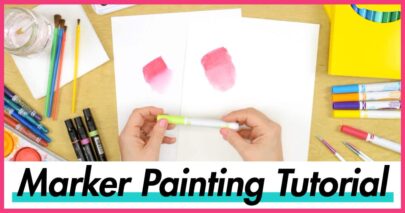
For 15 years, I covered up my art room windows with fall leaves, winter snowflakes, and spring flowers. It always looked terribly amateur and uninteresting. I wish I had thought of this window painting idea years ago. It would have saved me lots of time making crummy paper cutouts! And would have blocked the view much better.
You see, my art room sits on a courtyard that’s covered in blacktop. In the warmer months, the afternoon sun bounces off it and directly into my room creating a sauna effect.
Simultaneously, the preschool and kindergarten classes use the space.
Imagine you’re in the middle of directions and your firsties yell out, “Mrs. So-and-So is outside! I see her!”
Or, “Oh my gosh, it’s raining!” “Lightening!” “Snooooowww!”
Meanwhile, there’s 5 minutes left to hand in a project and they’re clearly not getting it done.
All. Day. Long.
Then one day the idea popped into my head: “Why not paint the windows and rope my 7th graders into helping?”
I wanted to create something with a rainbow of colors. But what? Hmmmmm…..
Art supplies! They’re so colorful and fun.
So I set myself to the task of planning out my idea.
Window Painting Art Supplies
- Liquid soap, preferably clear
- Acrylic Paint
- Paintbrushes (round and flat synthetic bristle brushes)
- Razor blade holder with replacement razor blades
- Wash rags
- Small, foam paint roller (optional)
Thoughts on Painting Supplies
 Painting Supplies
Painting Supplies
- SOAP: Clear liquid soap is better. That’s not to say you can’t use blue liquid soap. I’ve done it. But in the case of mixing the blue soap with yellow paint, I found it slightly dulls the yellow. It’s not a deal-breaker, just something to be aware of.
- MEASURING: I’ve seen elsewhere that you should use about 1 tsp. into a 1/4 cup of paint. I measured visually instead of using an actual teaspoon because, well, ain’t nobody got time for that! Not with a gaggle of 7th graders wanting paint, anyways.
- TEMPERA vs. ACRYLIC: I know some people recommend using liquid tempera paint because they feel like acrylic is hard to get of the windows. But I’m here to call boloney on that. Acrylic paint scrapes off fairly easily. Once you’ve scraped off what you can, you can use a soapy, wet rag to get the rest off. Tempera paint flakes off very easily. Don’t go through all that work to only be disappointed as you watch it flake away like Leonardo DaVinci’s, “The Last Supper.”
- BRUSHES: The kind of brushes you use matter. Natural bristle brushes will show every mark you make with the paint. Taklon brushes are my favorite. They’re made of synthetic fibers and will give your window painting a smooth appearance.
- RAZORS: You can search “razor blade holder” or “razor blade scraper” and see what I mean. It’s nice to have a few handy in case you goof up a window.
 Painting Windows Step-By-Step
Painting Windows Step-By-Step
First, I washed the windows to remove surface residue including that from dirt and masking tape. I used a razor blade to remove dried-up tape that was firmly stuck to the windows.
Then I measured the windows and decided on the width of each art supply. I created templates out of scrap poster board. In some cases I wrote colors on them for the students so they’d know what to paint each area.
Next, I taped the templates to the window and masked around the edge of the window frame with tape to prevent paint spills.
Then the students brushed on black paint. I wanted the background to have a different visual texture, so while the paint was still wet, they very gently rolled a paint roller across it. It picked up some of the paint and gave it a more rolled-on appearance.
We let the windows dry overnight and pulled off the templates. And this is where the real fun began. The students worked in tandem to paint the different areas. If one kid had the brown for the flat brush, they would paint all the others at the same time. This made it easier to accurately mix the colors (because in some cases, we had to do some mixing).
We made some goofs along the way and I’ll share those in a moment so you can learn from our mistakes.
Lastly, I spent a couple days outlining everything in black. It gave everything that added, “POP!” that was needed.
Window Painting Tips, Tricks, & Techniques
We made some mistakes that we learned from. At the beginning of the project, I instructed the kids to paint two layers of paint. In my defense, all I was thinking about was blocking that ugly blacktop, courtyard view! But it looked terrible. We got three-quarters of the way through painting one window pane and we decided to scrape it all off.

And this? Is how I know how well a simple razor blade and wet rag works to get off acrylic paint.
Once we got past that issue, a new one developed. I needed to teach the kids how to focus on their brushstrokes.

You can see from several examples here that in a simple rectangle shape, they were brushing in two directions. They needed to learn to brush in the direction of the shape.

So after some brushing mishaps, I painted a portion of one window pane to give them more concrete ideas on how to improve.
The last issue we ran into was the length of the brushstrokes. In some cases, students were filling a long shape with short strokes. If I caught them in time, it was an easy fix. If it had dried? We scraped it off and tried again.

One tip that worked: I told the students to paint past the edge of the shape, if possible, and once it’s dry, we could shape it with the razor. That worked well for us in the beginning. As we moved to areas where there was dried paint on either side, we used flat brushes to contour the edge of the shape.
Also, the black outlines became the savior of our window painting project. They cleaned up and hid all the mistakes!
 Conclusion
Conclusion
I would gladly do this project again with students! We had so much fun. Painting on windows is a much different experience than on paper, canvas, or cardboard. I would likely do a painting tutorial on paper with the students prior to starting on the window. I’d want to teach them how to control their brushstrokes.
They did such a great job on these windows that every teacher dropping their students off has remarked at our beautiful window painting. I’m already fielding requests.
If you have any questions about this, feel free to post a comment. I will be glad to respond. I hope you’ll give this a try and if you do, post a link below. If this tutorial helped you out, feel free to share it with other art teachers on Pinterest.

 Painting Supplies
Painting Supplies Painting Windows Step-By-Step
Painting Windows Step-By-Step Conclusion
Conclusion




Is this done on the inside or the outside of the window?
Does it look okay from both sides?
The pictures you see are how it looks painted on the inside. You should always paint on the inside so the paint doesn’t peel from in climate weather. And yes, it looks great from both sides. That’s because I had the kids outline in black first, then color them in, and then I outlined them in black a second time. This made it so there was a crisp black outline on both sides. Hope that helps!
Thinking about doing this on large windows overlooking our church courtyard for VBS.
Texas Summer heat…I need it to be easily removed. Do you think tempra is better for a short time period so it comes off easier ?
I’d never use tempera. It peels off easily. Throw some heat on that and I can only imagine it would peel like skin in the summer. The acrylic paint comes off easy. Just spray it with water and scrape.
I’m missing something? The liquid soap is used for?
So the paint doesn’t stick to the window (permanently).
Hi, this might be a silly question but is the liquid soap that you use hand soap? I’ve been asked to do some window art for a shop window and don’t want to get it wrong for my first time haha 🙂
Taz x
I’ve only ever used Dawn liquid soap, the kind you use to wash the dishes with. Clear is best, not the blue. Hope that helps!
Hey, Amie! I have a security question for you. In my school, we have shades that we can see out of, but (supposedly) one can’t see into. (You can early in the morning if it’s darker outside than inside.) Anyway, if we’re in an “active shooter” situation, I think I remember that we’re supposed to raise the shades so emergency workers can see in (kids would be hidden, so I’m not sure of the point of that). What are your thoughts on that, or did your admin say anything about your windows? They’re beautiful, and I, too, am on the playground, so it’s, “Oooh! Rain.” or snow, or “I wish we were at recess.” And the double pleasure of soccer and footballs hitting my windows ALL DAY EVERY DAY!
Thanks,
Brooke
Hey Brooke, honestly, you have to ask your admins. Every school is different with security measures. My school didn’t care about the painted windows. When we had drills, we always put our shades down. So I never had to touch the windows during drills because the blinds came down to the painted area. So the kids were always safe. We “hid” anyways, though. And by hiding I mean staying away from the front door. If you’re on a courtyard, you’re always going to be in plain sight.